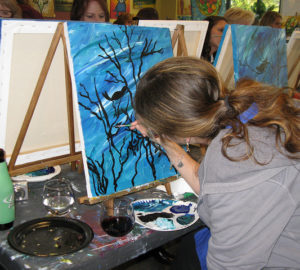
Foundation classes. Everyone takes them. Some people take them seriously, others don’t. The foundational education that every SCAD student receives constitutes just under a third of their studies.
This section of SCAD’s curriculum consists of 2D, 3D and 4D Design. It also includes various drawing classes and Color Theory and Application. It’s not uncommon for students to be overheard complaining about these graduation requirements. It’s typical for college students to complain about going to class, but why are SCAD students complaining about the classes that set them apart from a traditional four year school?
“I hate them. They’re tedious,” said Rayne Garnett, first-year illustration student. Garnett has taken four foundation classes (2D, 3D, Drawing I and Drawing II) and is already sick of the fluorescent classrooms and stool seats.
Fellow illustration major, second-year student Amanda Todd agreed. “They are definitely time consuming, but I must admit I really like the end results of each project,” Todd said.
On the flip side are students who really value the unique curriculum and treat foundation classes as major-related classes. “I enjoy taking them, and I certainly don’t feel like they’re a waste of my time. I can go back and apply the basic things I’ve learned to my major. It may be time consuming, but I see the need for them,” said first-year fashion design student Rachel Henderson. She is not alone. Fellow Color Theory classmate second-year, animation student David Hixon feels the same.
“Foundation classes are a good thing for a school like this. Any art school, really. They teach you the basics of art and help develop your skills,” he said.
Courses like Life Drawing and Color Theory might be useful to visual artists and fashion designers, but how much does it apply to other SCAD majors like writing and equestrian studies?
“Absolutely every student needs to take foundational studies,” said professor Dale Clifford, associate chair of the foundation department. “Foundation classes teach students perceptional skills that will enable them to look at the world around them differently. Instead of seeing generic items, they will see colors, texture and value. This goes especially for writers. The better they understand something, the better they can describe and transform things in the mind of a reader.”
According to SCAD’s website, the purpose of this foundational education is to enrich the creative mind and better the creation process. Students might not notice right away the connection between creating a cardboard head to their goals of being a television producer, but there is one. Being required to study the fundamentals of art allows students to learn to think outside the box.
“You have to be exposed to all arts to be an artist,” said Clifford. “Imagine if students only studied within their majors. How can a fashion student become inspired by something already done, if they don’t know how to look beyond it? Photography students would only create photos based on what they think they’re supposed to be. With foundational studies, they can begin to think about what photography can be.”

























